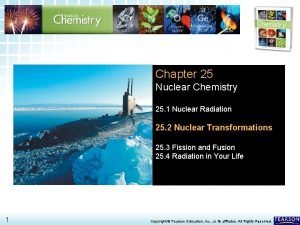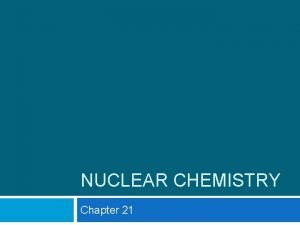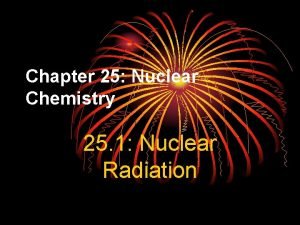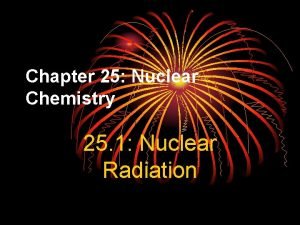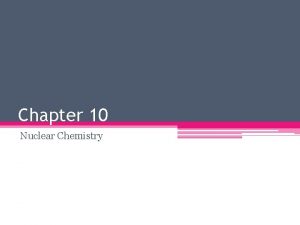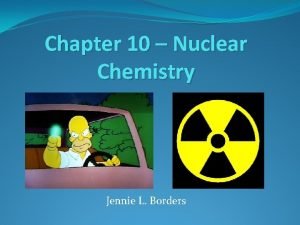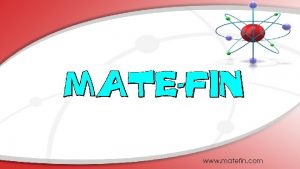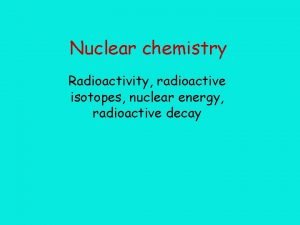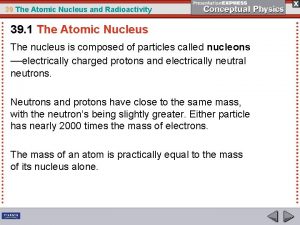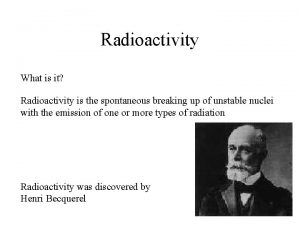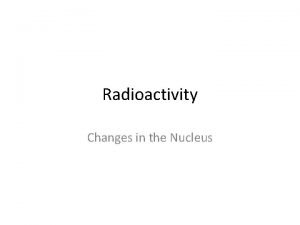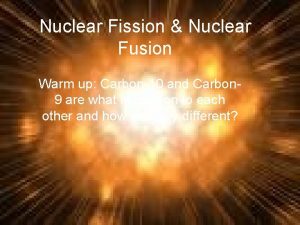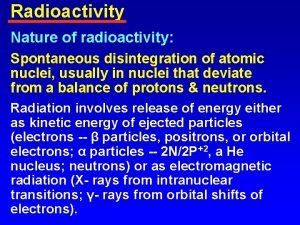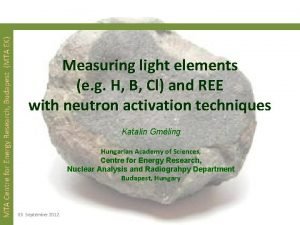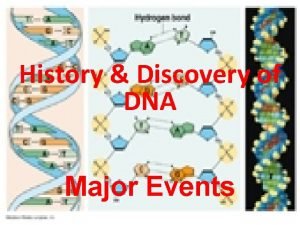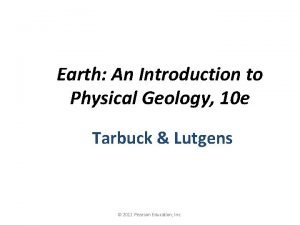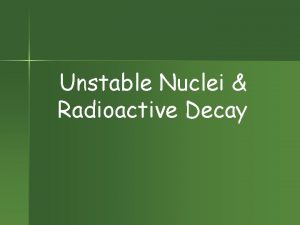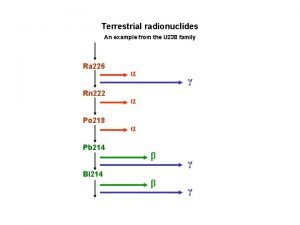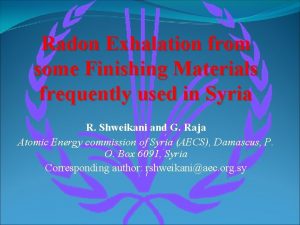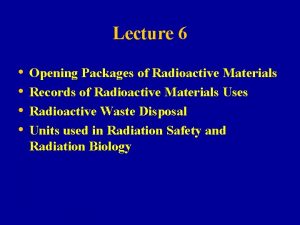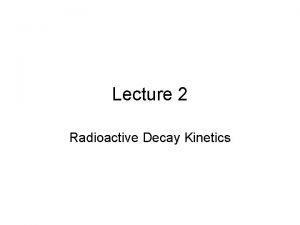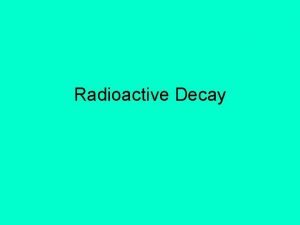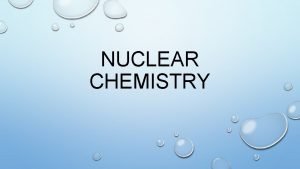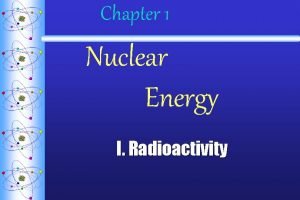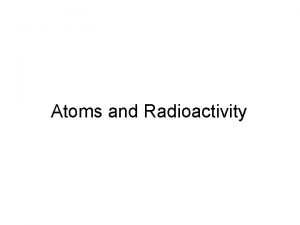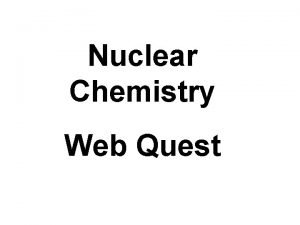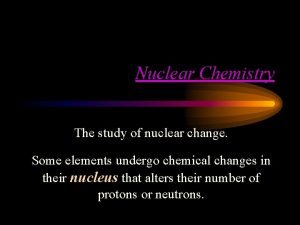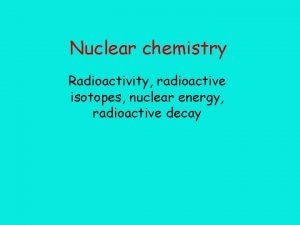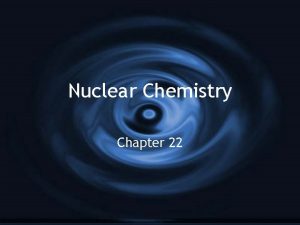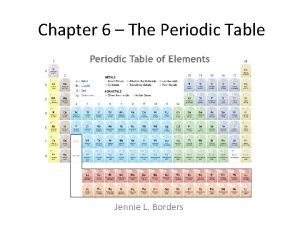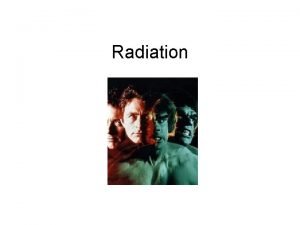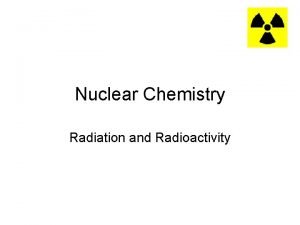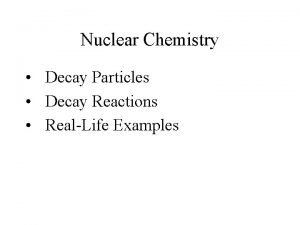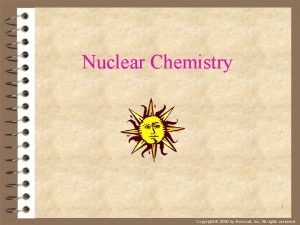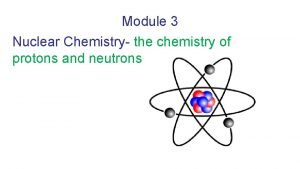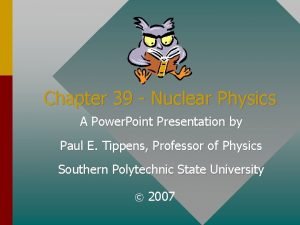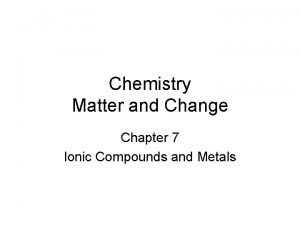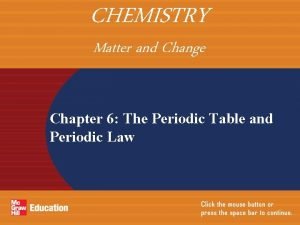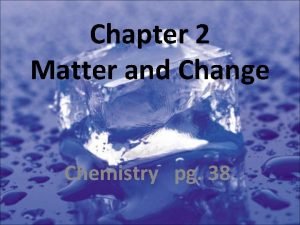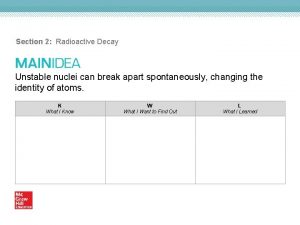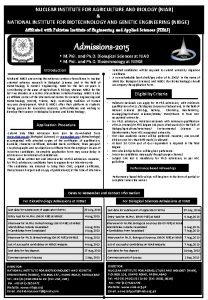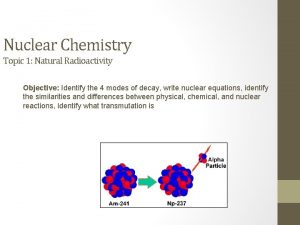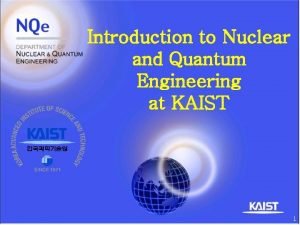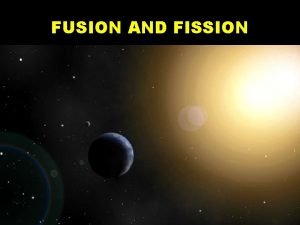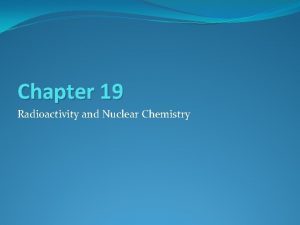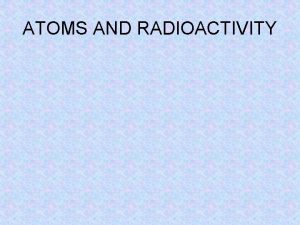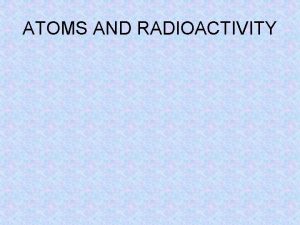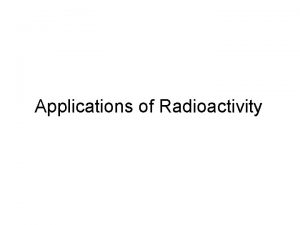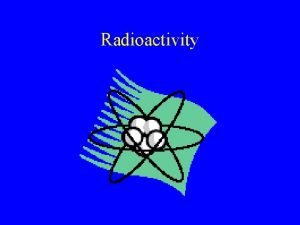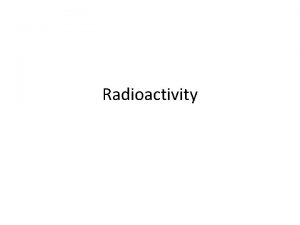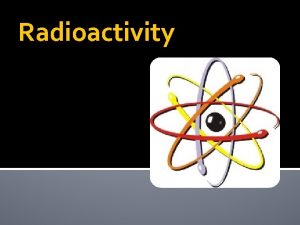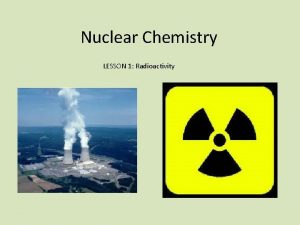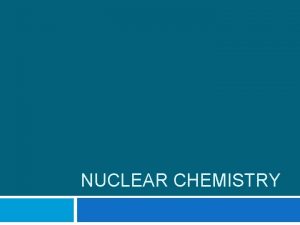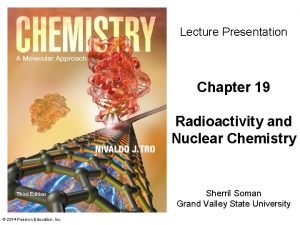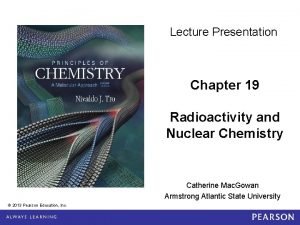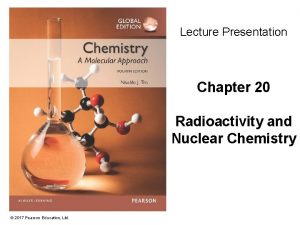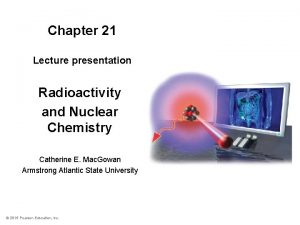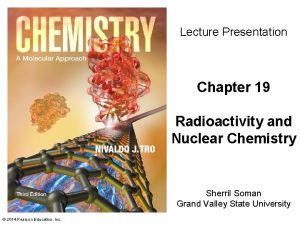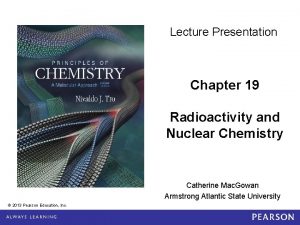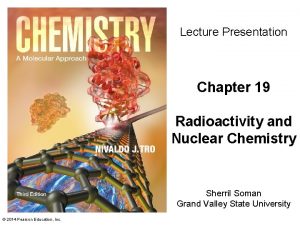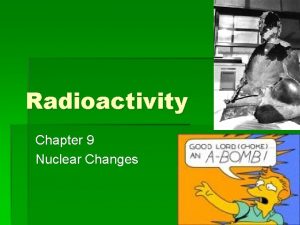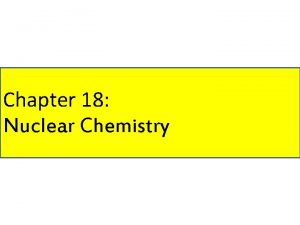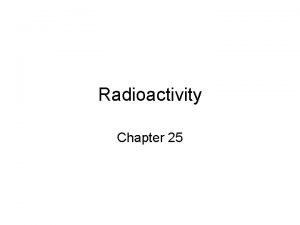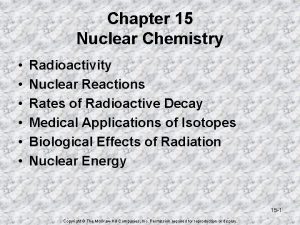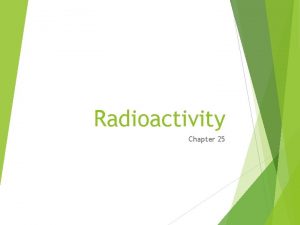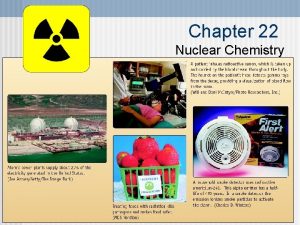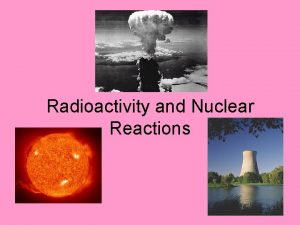Lecture Presentation Chapter 17 Radioactivity and Nuclear Chemistry












































































- Slides: 76

Lecture Presentation Chapter 17 Radioactivity and Nuclear Chemistry © 2018 Pearson Education, Inc. Dr. Sylvia Esjornson Southwestern Oklahoma State University Weatherford, OK

Radioactivity and Nuclear Chemistry • In nuclear medicine, radioactivity is used to obtain clear images of internal organs. © 2018 Pearson Education, Inc.

Diagnosing Appendicitis Using Nuclear Medicine • In a test for appendicitis, radioactively tagged antibodies are given to the patient. If the patient has an infection in the appendix, the antibodies accumulate there and the emitted radiation can be detected on photographic film. © 2018 Pearson Education, Inc.

Radioactivity is the emission of tiny, energetic particles by the nuclei of certain unstable atoms. © 2018 Pearson Education, Inc.

The Discovery of Radioactivity: Antoine. Henri Becquerel • In 1896, French scientist Antoine-Henri Becquerel (1852– 1908), discovered radioactivity. • Becquerel hypothesized that invisible emission of X-rays was associated with the visible greenish glow of phosphorescence. • To test his hypothesis, Becquerel placed crystals of a phosphorescent compound, potassium uranyl sulfate, on top of a photographic plate wrapped in black cloth. He placed the wrapped plate and the crystals outside to expose them to sunlight to make them phosphoresce. He knew that the crystals phosphoresced because he could see the emitted light when he brought them back into the dark. • If the crystals emitted X-rays as they phosphoresced, the X-rays would pass through the black cloth and expose the underlying photographic plate. The photographic plate did show a bright exposure spot where the crystals had been. • Becquerel believed his hypothesis was correct, that the emissions of phosphorescence and X-rays were linked, and he presented the results to the French Academy of Sciences. © 2018 Pearson Education, Inc.

Becquerel’s Experiment • Becquerel retracted his results when he discovered that a photographic plate with potassium uranyl sulfate crystals showed a bright exposure spot even when the plate and the crystals were stored in a dark drawer and were not exposed to sunlight nor emitting phosphoresce. • Becquerel realized that the crystals were constantly emitting something that exposed the photographic plate. • Becquerel concluded that it was the uranium within the crystals that was the source of the emissions, and he called the emissions uranic rays. © 2018 Pearson Education, Inc.

The Discovery of Radioactivity: Marie Sklodowska Curie • Marie Sklodowska Curie (1867– 1934), one of the first women in France to attempt doctoral work, pursued the study of uranic rays for her doctoral thesis. • Her first task was to determine whether any other substances besides uranium emitted uranic rays. • Curie discovered two new elements, both of which also emitted uranic rays. Curie named one of her newly discovered elements polonium after home country of Poland. © 2018 Pearson Education, Inc.

Curie Named the Second Element Radium because of the very high amount of radioactivity that it produced. • Radium was so radioactive that it glowed in the dark and emitted significant amounts of heat. • In the past, radium was added to some paints that were used on watch dials. The radium made the dial glow. © 2018 Pearson Education, Inc.

The Discovery of Radioactivity • In 1903, Curie received the Nobel Prize in physics—which she shared with Becquerel and her husband, Pierre Curie—for the discovery of radioactivity. • In 1911, Curie was awarded a second Nobel Prize, this time in chemistry, for her discovery of the two new elements polonium and radium. © 2018 Pearson Education, Inc.

The Discovery of Radioactivity: Marie Sklodowska Curie • Element 96 (curium) is named in honor of Marie Curie and her contributions to our understanding of radioactivity. • Marie Curie with her two daughters. Irene (right) became a distinguished nuclear physicist in her own right, winning a Nobel Prize in 1935. Eve (left) wrote a highly acclaimed biography of her mother. © 2018 Pearson Education, Inc.

Types of Radioactivity: Alpha, Beta, and Gamma Decay • While Curie focused her work on discovering the different kinds of radioactive elements, Ernest Rutherford and others focused on characterizing the radioactivity itself. • These scientists found that the emissions were produced by the nuclei of radioactive atoms. • The radioactive nuclei were unstable and would emit small pieces of themselves in the form of electromagnetic radiation to gain stability. • These were the particles that Becquerel and Curie detected. © 2018 Pearson Education, Inc.

Types of Radiation • There are several different types of radioactive emissions: alpha (α) rays, beta (β) rays, gamma (γ) rays, and positrons. • Nuclei are unstable when they are too large or contain an unbalanced ratio of neutrons to protons. • Small nuclei need about 1 neutron to every proton to be stable, while larger nuclei need about 1. 5 neutrons to every proton. © 2018 Pearson Education, Inc.

Isotope Notation Any isotope can be represented with the following notation: The main subatomic particles—protons, neutrons, and electrons—can be represented with similar notation. © 2018 Pearson Education, Inc.

Alpha Radiation Alpha (α) Radiation occurs when an unstable nucleus emits an α particle composed of 2 protons and 2 neutrons. © 2018 Pearson Education, Inc.

Nuclear Equations • A nuclear equation represents the changes that occur during radioactivity and other nuclear processes. • The nuclear equation for the alpha decay of uranium-238 is as follows: • In nuclear chemistry, we are primarily interested in changes within the nucleus; therefore, the 2+ charge that we would normally write for a helium nucleus is omitted for an alpha particle. © 2018 Pearson Education, Inc.

Nuclear Equations • The term nuclide is used in nuclear chemistry to mean a specific isotope. • The original atom is called the parent nuclide, and the products are called the daughter nuclides. • When an element emits an alpha particle, the number of protons in its nucleus changes, transforming it into a different element. • In chemical reactions, elements retain their identity; in a nuclear reaction, elements often change their identity as a result of a change in the number of protons in the nucleus. © 2018 Pearson Education, Inc.

Nuclear Equations Must Be Balanced • The sum of the atomic numbers on both sides of a nuclear equation must be equal, and the sum of the mass numbers on both sides must also be equal. © 2018 Pearson Education, Inc.

Writing Nuclear Equations for Alpha (α) Decay • We can deduce the mass number and atomic number of the unknown daughter nuclide because the equation must be balanced. © 2018 Pearson Education, Inc.

Writing Nuclear Equations for Alpha (α) Decay • Therefore, • The atomic number must be 88 and the mass number must be 228. • Finally, we can deduce the identity of the daughter nuclide and its symbol from its atomic number. Since the atomic number is 88, the daughter nuclide is radium (Ra). © 2018 Pearson Education, Inc.

Assessing the Damaging Power of Radiation • Radiation interacts with other molecules and atoms by ionizing them. • To ionize means to create ions (charged particles). • If radiation ionizes molecules within the cells of living organisms, those molecules become damaged and the cell can die or begin to reproduce abnormally. • The ability of radiation to ionize molecules and atoms is called its ionizing power. • Penetrating power is the ability to penetrate matter. In order for radiation to damage important molecules within living cells, it must penetrate the cell. © 2018 Pearson Education, Inc.

Alpha (α) Particle Radiation Damage Potential • Alpha radiation is the semi-truck of radioactivity. The alpha particle is the most massive of all particles emitted by radioactive nuclei. • Alpha radiation has the most potential to interact with and damage other molecules, including biological ones. Of all types of radioactivity, alpha radiation has the highest ionizing power. • Because of its large size, alpha radiation has the lowest penetrating power—the ability to penetrate matter. (Imagine a semi-truck trying to get through a traffic jam. ) • Alpha radiation does not easily penetrate cells; it can be stopped by a sheet of paper, by clothing, or even by air. • A low-level alpha emitter kept outside the body is relatively safe. • If an alpha emitter is ingested or inhaled, it becomes very dangerous because the alpha particles then have direct access to the biological molecules that compose organs and tissues. © 2018 Pearson Education, Inc.

Beta (β) Radiation • Beta radiation occurs when an unstable nucleus emits an electron. As the emission occurs, a neutron turns into a proton. © 2018 Pearson Education, Inc.

The Symbol for a Beta (β) Particle • The symbol for a beta particle in a nuclear equation is as follows: • The 0 in the upper left corner reflects the mass number of the electron. • The − 1 in the lower left corner reflects the charge of the electron, which is equivalent to an atomic number of − 1 in a nuclear equation. • When an atom emits a beta particle, its atomic number increases by one because it now has an additional proton. © 2018 Pearson Education, Inc.

Beta (β) Decay • The nuclear equation for the beta decay of radium-228 is as follows: • Notice that the nuclear equation is balanced—the sums of the mass numbers on both sides are equal, and the sums of the atomic numbers on both sides are equal. © 2018 Pearson Education, Inc.

Beta (β) Particle Radiation Damage Potential • Beta radiation is the midsized car of radioactivity. • Beta particles are much less massive than alpha particles and consequently have a lower ionizing power. • However, because of their smaller size, beta particles have greater penetrating power; a sheet of metal or a thick piece of wood is required to stop them. • Consequently, a low-level beta emitter outside the body poses a higher risk than an alpha emitter. • Inside the body, however, a beta emitter does less damage than an alpha emitter. © 2018 Pearson Education, Inc.

Gamma (γ) Radiation • It is different from alpha or beta radiation. Gamma radiation is not matter but electromagnetic radiation. • Gamma rays are high-energy (short-wavelength) photons. The symbol for a gamma ray is as follows: • A gamma ray has no charge and no mass. • Gamma rays are usually emitted in conjunction with other types of radiation. • The alpha emission of U-238 is accompanied by the emission of a gamma ray. © 2018 Pearson Education, Inc.

Gamma (γ) Ray Radiation Damage Potential • Gamma rays are the motorbikes of radioactivity. • They have the lowest ionizing power but the highest penetrating power. (Imagine a motorbike zipping through a traffic jam. ) • Stopping gamma rays requires several inches of lead shielding or thick slabs of concrete. © 2018 Pearson Education, Inc.

Positron Emission Positron emission occurs when an unstable nucleus emits a positron. As the emission occurs, a proton turns into a neutron. © 2018 Pearson Education, Inc.

Positron Emission • The symbol for a positron in a nuclear equation is as follows: • The 0 in the upper left corner reflects that a positron has a mass number of 0. • The +1 in the lower left corner reflects the charge of the positron, which is equivalent to an atomic number of +1 in a nuclear equation. • When an atom emits a positron, its atomic number decreases by 1 because it now has 1 fewer proton. © 2018 Pearson Education, Inc.

Positron Emission • The nuclear equation for the positron emission of phosphorus-30 is as follows: • Notice that the nuclear equation is balanced—the sums of the mass numbers on both sides are equal, and the sums of the atomic numbers on both sides are equal. • Positron emission is similar to beta emission in its ionizing and penetrating power. © 2018 Pearson Education, Inc.

Radiation Summary To summarize: Alpha particles are composed of 2 protons and 2 neutrons. • Alpha particles have high ionizing power. • Alpha particles have low penetrating power. Beta particles are electrons emitted from atomic nuclei when a neutron changes into a proton. • Beta particles have intermediate ionizing power. • Beta particles have intermediate penetrating power. Positron emission is similar to beta emission in its ionizing and penetrating power. Gamma rays are electromagnetic radiation—high-energy, short-wavelength photons. • Gamma rays have low ionizing power. • Gamma rays have high penetrating power. © 2018 Pearson Education, Inc.

© 2018 Pearson Education, Inc.

Detecting Radioactivity • Film-badge dosimeters consist of photographic film held in a small case that is pinned to clothing. • The badges are collected and processed as a way to monitor exposure to radiation. • The more exposed the film has become in a given period of time, the more radioactivity to which the person has been exposed. © 2018 Pearson Education, Inc.

Geiger-Müller Counter • Energetic particles emitted by radioactive nuclei pass through a chamber filled with argon gas and ionize it. • When an argon atom is ionized, it is attracted to the anode and the dislodged electron is attracted to the cathode, creating a tiny electrical current. • This electrical signal can be detected on a meter or turned into an audible click. • This clicking is the stereotypical sound most people associate with a radiation detector. © 2018 Pearson Education, Inc.

Detecting Radioactivity • Another type of device commonly used to detect radiation instantly is a scintillation counter. • In a scintillation counter, the radioactive emissions pass through a material (such as Na. I or Cs. I) that emits ultraviolet or visible light in response to excitation by energetic particles. • This light is detected and turned into an electrical signal that can be read on a meter. © 2018 Pearson Education, Inc.

Natural Radioactivity (Background Radiation) • The naturally occurring radioactive elements in our environment are all undergoing radioactive decay. They are present in our environment because they have very long half-lives (billions of years) or they are continuously being formed by some other process in the environment. • One reason for the radioactivity in our environment is the instability of all atomic nuclei beyond atomic number 83 (bismuth). • Some isotopes of elements with fewer than 83 protons are also unstable and radioactive. • The ground beneath you and the food you eat contain a residual number of radioactive atoms that enter into your body fluids and tissues. • Small amounts of radiation from space make it through our atmosphere and constantly bombard Earth. • Humans and other living organisms have evolved in this environment and have adapted to survive in it. © 2018 Pearson Education, Inc.

The Concept of Half-Life • The time it takes for half of the parent nuclides in a radioactive sample to decay to the daughter nuclides is called the half-life. • A radioactive sample does not decay to zero atoms in two half-lives—you can’t add two half-lives together to get a “whole” life. • The amount that remains after one half-life is always one-half of what was present at the start. • The amount that remains after two half-lives is one-quarter of what was present at the start. • The amount that remains after three half-lives is one-eighth of what was present at the start. © 2018 Pearson Education, Inc.

Illustration of Half-Life A plot of the number of Th-232 atoms in a sample initially containing 1 million atoms as a function of time. Th-232 has a half-life of 14 billion years. © 2018 Pearson Education, Inc.

Different Nuclides Decay at Different Rates • Thorium-232 has a half-life of 1. 4 × 1010, or 14 billion years. • Radon-220 has a half-life of approximately 1 minute. © 2018 Pearson Education, Inc.

Selected Nuclides and Their Half-Lives • Each radioactive nuclide has a unique half-life that is not affected by physical conditions or chemical environment. © 2018 Pearson Education, Inc.

A Natural Radioactive Decay Series • Uranium (atomic number 92) is the heaviest naturally occurring element. • U-238 is an alpha emitter that decays to thorium-234 with a half-life of 4. 47 billion years. • The thorium daughter nuclide, Th-234, is radioactive—it is a beta emitter that decays to protactinium-234 with a half-life of 24. 1 days. • The protactinium daughter nuclide, Pa-234, is also radioactive, decaying to uranium-234 via beta emission with a half-life of 244, 500 years. • This process continues through several steps, including the formation of radon gas, until it produces lead-206, which is stable. • All of the uranium-238 in the environment is slowly decaying away to lead-206. • Since the half-life for the first step in the series is a very long time, there is still a large amount of uranium-238 in the environment. • All of the other nuclides in the decay series are also present in the environment in varying amounts, depending on their half-lives. © 2018 Pearson Education, Inc.

A Natural Radioactive Decay Series © 2018 Pearson Education, Inc.

Chemistry and Health: Environmental Radon • Radon—a radioactive gas—is one of the products of the natural radioactive decay series of uranium. • Wherever there is uranium in the ground, there is likely to be radon seeping up into the air. • If the gas is trapped in a dwelling enclosure, radon and its daughter nuclides can attach to dust particles and then be inhaled into the lungs, where they decay radioactively and increase lung cancer risk. • The radioactive decay of radon is by far the single greatest source of human radiation exposure. • Radon-222 has a half-life of 3. 8 days. © 2018 Pearson Education, Inc.

Map of the United States Showing Radon Levels Zone 1 counties have the highest levels, and zone 3 counties have the lowest. • Homes built in areas with significant uranium deposits in the ground pose the greatest risk. • Excessively high indoor radon levels require the installation of a ventilation system to purge radon from the house. Lower levels can be ventilated by keeping windows and doors open. © 2018 Pearson Education, Inc.

Radiocarbon Dating: Using Radioactivity to Measure the Age of Fossils and Other Artifacts • Scientists take advantage of the presence of natural radioactivity in our environment to estimate the ages of fossils and artifacts with a technique called radiocarbon dating. • Ancient artifacts contain a radioactive signature that reveals their age. • This signature results from the presence of carbon-14—which is radioactive—in the environment. © 2018 Pearson Education, Inc.

Radiocarbon Dating The continuous formation of carbon-14 in the atmosphere and its continuous decay back to nitrogen-14 produce a nearly constant equilibrium concentration of atmospheric carbon-14. • Carbon-14 is constantly formed in the upper atmosphere by the neutron bombardment of nitrogen. The carbon-14 is oxidized to carbon dioxide and incorporated into plants by photosynthesis. • Carbon-14 decays back to nitrogen by beta emission, with a half-life of 5715 years. © 2018 Pearson Education, Inc.

Radiocarbon Dating • The carbon-14 is incorporated into animals because animals depend on plants for food (they either eat plants or eat other animals that eat plants). • All living organisms contain a residual amount of carbon-14. • When a living organism dies, it stops incorporating new carbon-14 into its tissues. • The carbon-14 present at the time of death decays with a half-life of 5715 years. • Since many artifacts are made from materials that were once living—such as papyrus, wood, and other plant and animal derivatives—the amount of carbon-14 in these artifacts relative to living organisms indicates the date of their death. © 2018 Pearson Education, Inc.

Radiocarbon Dating • If an ancient artifact has a carbon-14 concentration that is 50% of that found in living organisms, it must be one half-life, or 5715 years old. • If the artifact has a carbon-14 concentration that is 25% of that found in living organisms, its age is two half-lives, or 11, 430 years old. © 2018 Pearson Education, Inc.

The Discovery of Nuclear Fission: Fermi’s Role • In the mid-1930 s, Enrico Fermi (1901– 1954), an Italian physicist, tried to synthesize a new element by bombarding uranium with neutrons. • Fermi hypothesized that if a neutron were incorporated into the nucleus of a uranium atom, the nucleus might undergo beta decay, converting a neutron into a proton. • If that happened, a new element, with atomic number 93, would be synthesized for the first time. The nuclear equation for the process is as follows: • Fermi performed the experiment and detected the emission of beta particles, which suggested the formation of another proton. • Fermi never chemically examined the products to determine their composition and could not say whether he had synthesized a new element. © 2018 Pearson Education, Inc.

Pioneers in Nuclear Fission • The element with atomic number 100 is named fermium, in honor of Enrico Fermi. • The element with atomic number 109 is named meitnerium, in honor of Lise Meitner. © 2018 Pearson Education, Inc.

The Discovery of Nuclear Fission • The essence of Fermi’s idea was the bombarding of uranium with neutrons. • Three researchers in Germany—Lise Meitner (1878– 1968), Fritz Strassmann (1902– 1980), and Otto Hahn (1879– 1968) —repeated Fermi’s experiments and then performed careful chemical analysis of the products. © 2018 Pearson Education, Inc.

Nuclear Fission Reported On January 6, 1939, Meitner, Strassmann, and Hahn reported that the neutron bombardment of uranium resulted in nuclear fission—the splitting of the atom. © 2018 Pearson Education, Inc.

Enriched U-235 in Nuclear Fission • The initial uranium atom is the U-235 isotope, which composes less than 1% of all naturally occurring uranium. • The most abundant uranium isotope, U-238, does not undergo fission. • The uranium used for fuel in nuclear reactions must be enriched in U-235 (it must contain more than the naturally occurring percentage of U-235). • The process produces three neutrons, which have the potential to initiate fission in three other U-235 atoms. © 2018 Pearson Education, Inc.

Fission Chain Reaction The neutrons produced by the fission of one uranium nucleus induce fission in other uranium nuclei to produce a self-amplifying reaction. © 2018 Pearson Education, Inc.

History of the Atomic Bomb • U. S. scientists realized that uranium enriched with U-235 could undergo a chain reaction. The result would be a self-amplifying reaction capable of producing an enormous amount of energy— an atomic bomb. • To make a bomb, a critical mass of U-235—enough U-235 to produce a self-sustaining reaction—would be necessary. • Several U. S. scientists persuaded Albert Einstein to write a letter to President Franklin Roosevelt warning of the possibility of Germany constructing an atomic bomb. • Einstein wrote, “and it is conceivable—though much less certain —that extremely powerful bombs of a new type may thus be constructed. A single bomb of this type, carried by boat and exploded in a port, might very well destroy the whole port together with some of the surrounding territory. ” © 2018 Pearson Education, Inc.

History of the Atomic Bomb • In 1941, Roosevelt assembled the resources for the top-secret Manhattan Project. Its main goal was to build an atomic bomb before the Germans did. • The project was led by physicist J. R. Oppenheimer (1904– 1967) and was headquartered at the high-security research facility in Los Alamos, New Mexico. • Four years later, on July 16, 1945, the world’s first nuclear weapon was detonated at a test site in New Mexico. The first atomic bomb exploded with a force equivalent to 18, 000 tons of dynamite. • Meanwhile, the Germans had not been successful in making a nuclear bomb and had already been defeated by this time. • Instead, the atomic bomb was used on Japan. One bomb was dropped on Hiroshima, and a second bomb was dropped on Nagasaki. Together, the bombs killed approximately 200, 000 people and forced Japan to surrender. • World War II was ended. © 2018 Pearson Education, Inc.

The Testing of the World’s First Nuclear Bomb at Alamogordo, New Mexico, in 1945 © 2018 Pearson Education, Inc.

Nuclear Power: Using Fission to Generate Electricity • A nuclear-powered electrical plant can produce a lot of electricity with a small amount of fuel. • Nuclear power plants generate electricity by using fission to generate heat. • The heat is used to boil water and create steam, which turns the turbine on a generator to produce electricity. © 2018 Pearson Education, Inc.

Nuclear Power • The fission reaction occurs in the nuclear core of the power plant, or reactor. • The water carrying heat from the reactor core is contained within separate pipes and does not come into direct contact with the steam that drives the turbines. © 2018 Pearson Education, Inc.

Nuclear Power • The core of a nuclear reactor consists of enriched 3. 5% U-235 uranium fuel rods interspersed with retractable neutron-absorbing control rods. • When the control rods are fully retracted from the fuel rod assembly, the chain reaction can propagate itself. • When the control rods are fully inserted into the fuel assembly, they absorb the neutrons that would otherwise induce fission, shutting down the chain reaction. Technicians inspect the core of a nuclear reactor, which houses the fuel rods and control rods. © 2018 Pearson Education, Inc.

Problems at Chernobyl Nuclear Power Generator • In spite of safety precautions, the fission reaction occurring in a nuclear power plant can overheat. • This type of accident occurred in Chernobyl in the former Soviet Union on April 26, 1986. • Operators were performing an experiment designed to reduce maintenance costs. In order to perform the experiment, many of the safety features of the reactor core were disabled. • The experiment failed, with disastrous results. • The nuclear core, composed partly of graphite, overheated and began to burn. • The accident caused 31 deaths directly and produced a fire that scattered radioactive debris into the atmosphere, making the surrounding countryside uninhabitable. The overall death toll from subsequent cancers is undetermined at this time. • Reactor cores in the United States are not made of graphite and could not burn in the way that the Chernobyl core did. © 2018 Pearson Education, Inc.

Problems at Fukushima Nuclear Power Generator • • • Another accident occurred at the Fukushima Daiichi Nuclear Power Plant in Japan in March of 2011. A 9. 0 magnitude earthquake triggered a tsunami that flooded the coastal plant and caused the plant’s cooling system pumps to fail. Several of the nuclear cores within the plant overheated, and at least one of the cores experienced a partial meltdown (in which the fuel gets so hot that it melts). The accident was intensified by the loss of water in the fuel-storage coolingponds, which caused the fuel stored in the ponds to also overheat. The release of radiation into the environment, while significant, was lower in Japan than at Chernobyl. Even several years after the accident, no radioactivity-related deaths have been reported at the Fukushima plant or the surrounding area. The cleanup of the site, however, will continue for many years. U. S. nuclear power plants have additional safety features designed to prevent similar accidents. For example, U. S. nuclear power plants have large containment structures designed to contain radioactive debris in the event of an accident. © 2018 Pearson Education, Inc.

Some Problems with Nuclear Power Generation Waste Disposal • The amount of nuclear fuel used in electricity generation is small compared to that of other fuels; however, the products of the reaction are radioactive and have very long half-lives (thousands of years or more). • Currently, in the United States, nuclear waste is stored on site at the nuclear power plants. • A permanent disposal site was being developed in Yucca Mountain, Nevada. The site had originally been scheduled to be operational in 2010 and that date was later delayed to 2017. • The Obama administration determined that the Yucca Mountain site was untenable, and in the spring of 2010, the license application to develop this site was withdrawn. • President Obama has also formed a committee (called the Blue Ribbon Commission on America’s Nuclear Future) that is charged with developing alternatives to Yucca Mountain. © 2018 Pearson Education, Inc.

Nuclear Fusion: The Power of the Sun • Nuclear fusion is the combination of two light nuclei to form a heavier one. • In stars, hydrogen atoms fuse together to form helium atoms, emitting energy in the process. • Nuclear fusion is the basis of nuclear weapons called hydrogen bombs. A modern hydrogen bomb has up to 1000 times the explosive force of the first atomic bombs. These bombs employ the following fusion reaction: • In this reaction, deuterium (the isotope of hydrogen with one neutron) and tritium (the isotope of hydrogen with two neutrons) combine to form helium-4 and a neutron. © 2018 Pearson Education, Inc.

Feasibility of Nuclear Fusion for Electric Power Generation • Because fusion reactions require two positively charged nuclei (which repel each other) to fuse together, extremely high temperatures are required. • In a hydrogen bomb, a small fission bomb is detonated first, providing temperatures high enough for fusion to proceed. • Nuclear fusion has been intensely investigated as a way to produce electricity. • One of the main problems is the high temperature required for fusion to occur—no building materials can withstand these temperatures. • Whether fusion will ever be a viable energy source remains to be seen. © 2018 Pearson Education, Inc.

The Effects of Radiation on Life Acute Radiation Damage • Acute radiation damage results from exposure to large amounts of radiation in a short period of time. • The main sources of this kind of exposure are nuclear bombs or exposed nuclear reactor cores. • The high levels of radiation kill large numbers of cells. • Rapidly dividing cells, such as those in the immune system and the intestinal lining, are most susceptible. • People exposed to high levels of radiation have weakened immune systems and a lowered ability to absorb nutrients from food. • In milder cases, recovery is possible with time. • In more extreme cases, death results, often from infection. © 2018 Pearson Education, Inc.

The Effects of Radiation on Life Increased Cancer Risk • Lower doses of radiation over extended periods of time can increase cancer risk because radiation can damage DNA. • When the DNA within a cell is damaged, the cell normally dies. • Changes in DNA can cause cells to grow abnormally and to become cancerous. • Cancerous cells grow into tumors that can spread and, in some cases, cause death. • Cancer risk increases with increased radiation exposure. • It is difficult to separate an exact threshold for increased cancer risk from radiation exposure when compared to other factors. © 2018 Pearson Education, Inc.

The Effects of Radiation on Life Genetic Defects • Another possible effect of radiation exposure is genetic defects in offspring. • If radiation damages the DNA of reproductive cells—such as eggs or sperm—then the offspring that develop from those cells may have genetic abnormalities. • Genetic defects of this type have been observed in laboratory animals exposed to high levels of radiation. • Genetic defects of this type—with a clear causal connection to radiation exposure—have not yet been observed in humans, even in studies of Hiroshima survivors. © 2018 Pearson Education, Inc.

Measuring Radiation Exposure Common Units of Radioactivity: • The curie is defined as 3. 7 × 1010 decay events per second. • The roentgen is defined as the amount of radiation that produces 2. 58 × 10– 4 coulombs of charge per kilogram of air. • Human radiation exposure is often reported in a unit called the rem. The rem, which stands for roentgen equivalent man, is a weighted measure of radiation exposure that accounts for the ionizing power of the different types of radiation. © 2018 Pearson Education, Inc.

Radiation Exposure by Source • On average, each of us is exposed to approximately one-third of a rem of radiation per year. • This radiation comes primarily from natural sources, especially radon, one of the products in the uranium decay series. © 2018 Pearson Education, Inc.

Effects of Radiation Exposure • It takes more radiation than the natural amount to produce measurable health effects in humans. • The first measurable effects, a decreased white blood cell count, occur at instantaneous exposures of approximately 20 rem. © 2018 Pearson Education, Inc.

Effects of Radiation Exposure • An isotope scan Technetium-99 is often used as the radiation source for bone scans such as this one. • Phosphorus-32 is used to image tumors because it is preferentially taken up by cancerous tissue. • Iodine-131 is used to diagnose thyroid disorders. © 2018 Pearson Education, Inc.

Radiotherapy for Cancer • Treatment involves exposing a malignant tumor to gamma rays, typically from radioisotopes such as cobalt-60. • The beam is moved in a circular pattern around the tumor to maximize exposure of the cancer cells while minimizing exposure of healthy tissues. © 2018 Pearson Education, Inc.

Chapter 17 in Review • The nature and discovery of radioactivity: alpha particles, beta particles, positron particles, and gamma rays (high-energy, short-wavelength photons) • Radioactivity can be detected over time with photographic film. • Detection devices such as a Geiger-Müller counter or a scintillation counter give instantaneous readings of radiation levels. © 2018 Pearson Education, Inc.

Chapter 17 in Review • The half-life of a radioactive nuclide is the time it takes for half of the parent nuclides in a radioactive sample to decay. • The presence of radioactive carbon-14 (with a half-life of 5715 years) in the environment provides a natural clock by which to estimate the age of many artifacts and fossils. • Fission—the splitting of the atom into smaller fragments—was discovered in 1939. Fission occurs when a U-235 nucleus absorbs a neutron. The nucleus becomes unstable, breaking apart and producing barium, krypton, neutrons, and energy. • Nuclear fusion is the combination of two light nuclei to form a heavier one. Nuclear fusion is the energy source of stars, including our sun. • Radiation can damage molecules within living cells. Instantaneous high exposure to radiation can lead to radiation sickness and death. Longterm exposure at lower levels can increase cancer risk. • Radiation is used to attack cancerous tumors and to image internal organs through isotope scanning. © 2018 Pearson Education, Inc.

Chemical Skills Learning Objectives 1. 2. 3. 4. 5. LO: Write nuclear equations for alpha decay. LO: Write nuclear equations for beta decay. LO: Write nuclear equations for positron decay. LO: Use half-life. LO: Use carbon-14 content to determine the age of fossils or artifacts. © 2018 Pearson Education, Inc.
 Key terms radioactivity and nuclear reactions
Key terms radioactivity and nuclear reactions 12x12x12x12x12x12x12
12x12x12x12x12x12x12 Chapter 25 nuclear chemistry answer key
Chapter 25 nuclear chemistry answer key Chapter 21 review nuclear chemistry
Chapter 21 review nuclear chemistry Nuclear fusion
Nuclear fusion Chapter 25 nuclear chemistry
Chapter 25 nuclear chemistry Chapter 10 nuclear chemistry
Chapter 10 nuclear chemistry Chapter 10 nuclear chemistry
Chapter 10 nuclear chemistry Lesson 15 nuclear quest nuclear reactions
Lesson 15 nuclear quest nuclear reactions Fisión nuclear vs fision nuclear
Fisión nuclear vs fision nuclear Natural and artificial radioactivity
Natural and artificial radioactivity Nuclear transmutation equation
Nuclear transmutation equation Natural and artificial radioactivity
Natural and artificial radioactivity Atoms and radioactivity
Atoms and radioactivity 01:640:244 lecture notes - lecture 15: plat, idah, farad
01:640:244 lecture notes - lecture 15: plat, idah, farad Who discovered radioactivity
Who discovered radioactivity Who discovered radioactivity
Who discovered radioactivity Are nuclear power plants fission or fusion
Are nuclear power plants fission or fusion Law of radioactive decay
Law of radioactive decay Radioactivity as spontaneous disintegration
Radioactivity as spontaneous disintegration Radioactivity
Radioactivity Radioactivity
Radioactivity Unconformity
Unconformity Natural radioactivity
Natural radioactivity Environmental radioactivity
Environmental radioactivity Natural radioactivity
Natural radioactivity Radioactivity phenomenon
Radioactivity phenomenon Units of radioactivity
Units of radioactivity Radioactive decay formula
Radioactive decay formula Defination of radioactivity
Defination of radioactivity Defination of radioactivity
Defination of radioactivity Defination of radioactivity
Defination of radioactivity Uranium 238 alpha decay equation
Uranium 238 alpha decay equation Nuclear chemistry webquest answer key
Nuclear chemistry webquest answer key Chemistry
Chemistry Application of nuclear chemistry
Application of nuclear chemistry Application of nuclear chemistry
Application of nuclear chemistry Zeff trend
Zeff trend Nuclear chemistry review worksheet answer key
Nuclear chemistry review worksheet answer key 25 m/s
25 m/s T half life formula
T half life formula Real life examples of fusion
Real life examples of fusion Copyright
Copyright Nitrogen-13 decay equation
Nitrogen-13 decay equation Applications of nuclear chemistry
Applications of nuclear chemistry Nuclear physics topics for presentation
Nuclear physics topics for presentation Advanced inorganic chemistry lecture notes
Advanced inorganic chemistry lecture notes An introduction to atmospheric physics
An introduction to atmospheric physics Lecture presentation software
Lecture presentation software Ib organic chemistry functional groups
Ib organic chemistry functional groups Inorganic chemistry vs organic chemistry
Inorganic chemistry vs organic chemistry Occipital brow presentation
Occipital brow presentation 4 maneuvers of leopold
4 maneuvers of leopold Human resource management 15th edition
Human resource management 15th edition Intro to human resource management
Intro to human resource management Human resource management lecture chapter 1
Human resource management lecture chapter 1 Chemistry matter and change chapter 7
Chemistry matter and change chapter 7 Chapter 10 assessment the mole answer key
Chapter 10 assessment the mole answer key Chapter 8 review chemical equations and reactions
Chapter 8 review chemical equations and reactions Chapter 9 chemical names and formulas answer key
Chapter 9 chemical names and formulas answer key 1s 22 s22 p63 s23 p64 s2
1s 22 s22 p63 s23 p64 s2 Chemistry matter and change chapter 6
Chemistry matter and change chapter 6 Chapter 10 study guide the mole
Chapter 10 study guide the mole 2 matter and change answer key
2 matter and change answer key Oxygen periodic trends
Oxygen periodic trends Anatomy and physiology chapter 2
Anatomy and physiology chapter 2 7 ionic and metallic bonding practice problems
7 ionic and metallic bonding practice problems Physics topic 12
Physics topic 12 Pros cons of biomass energy
Pros cons of biomass energy Conclusion on topic family
Conclusion on topic family Nuclear decays and reactions section 2
Nuclear decays and reactions section 2 Nuclear institute for agriculture and biology
Nuclear institute for agriculture and biology Nuclear fission and fusion similarities
Nuclear fission and fusion similarities Nuclear and quantum engineering
Nuclear and quantum engineering Nuclear fission and fusion similarities
Nuclear fission and fusion similarities Advantages of single parent family
Advantages of single parent family Fission vs fusion
Fission vs fusion


